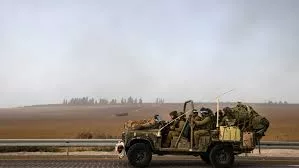Rising tensions between Israel and Iran have pushed the region closer to the edge of conflict, with the US reaffirming its commitment to support Israel.
The US maintains a substantial military presence in the Middle East, comprising around 45,000 personnel, numerous bases, and a powerful air and naval fleet, raising concerns about a potential regional conflict.
Recent events, including the assassination of Hamas political chief Ismail Haniyeh in Tehran and the killing of Hezbollah commander Fouad Shukr in Lebanon, have further escalated tensions and fueled speculation about possible Iranian retaliation.
As global attention turns to Tehran’s next actions, questions arise about how the US will assist its ally, Israel.
The US military presence in the Middle East has been long-standing, peaking in 2007 with 160,000 personnel in Iraq and over 100,000 in Afghanistan in 2011. Although troop levels in Iraq have decreased and the US withdrew from Afghanistan in 2021, additional troops have been deployed to the region since the onset of Israel’s assault on Gaza on October 7.
Reports indicate that the US operates from various bases across the region, maintaining a rotational force of about 45,000 troops.
Key locations include:
- Al Udeid Air Base in Qatar, with around 8,000 personnel, serving as the regional headquarters for US Central Command (CENTCOM).
- Bahrain, hosting the US 5th Fleet headquarters with about 9,000 personnel.
- Kuwait, housing 13,500 troops, a critical logistical hub during the 2003 Iraq war.
- United Arab Emirates, accommodating approximately 3,500 US military personnel and essential US Navy ports.
- Jordan, hosting around 3,000 troops, vital for intelligence operations despite a recent attack by Iranian-backed militias.
- Saudi Arabia, with over 2,700 troops focused on training and advising local forces and protecting US interests.
- Oman and other smaller deployments across the region, contributing to the overall US military strategy.
In Israel, the US operates the secretive Site 512 base for radar surveillance against ballistic missile threats and supports the Iron Dome missile defense system at Nevatim Airbase.
In Iraq and Syria, the US maintains about 3,500 personnel, focusing on non-combat advisory roles and training local forces. This includes approximately 900 special forces in Syria supporting the YPG/PKK, also known as the SDF.
The Pentagon has recently announced additional deployments of warships and aircraft to the region in response to recent events, including 18 American ships and the deployment of two aircraft carriers, the USS Gerald Ford and USS Eisenhower, along with support ships and around 2,000 marines. Additional fighter jets have been deployed to bolster existing fleets in the Middle East.




